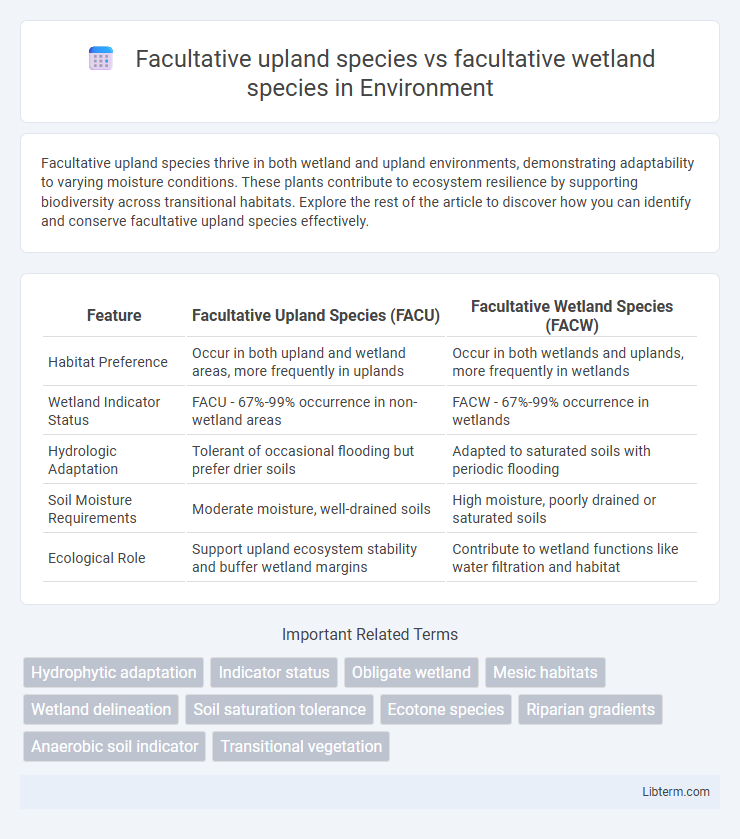Facultative upland species thrive in both wetland and upland environments, demonstrating adaptability to varying moisture conditions. These plants contribute to ecosystem resilience by supporting biodiversity across transitional habitats. Explore the rest of the article to discover how you can identify and conserve facultative upland species effectively.
Table of Comparison
| Feature | Facultative Upland Species (FACU) | Facultative Wetland Species (FACW) |
|---|---|---|
| Habitat Preference | Occur in both upland and wetland areas, more frequently in uplands | Occur in both wetlands and uplands, more frequently in wetlands |
| Wetland Indicator Status | FACU - 67%-99% occurrence in non-wetland areas | FACW - 67%-99% occurrence in wetlands |
| Hydrologic Adaptation | Tolerant of occasional flooding but prefer drier soils | Adapted to saturated soils with periodic flooding |
| Soil Moisture Requirements | Moderate moisture, well-drained soils | High moisture, poorly drained or saturated soils |
| Ecological Role | Support upland ecosystem stability and buffer wetland margins | Contribute to wetland functions like water filtration and habitat |
Introduction to Facultative Plant Species
Facultative upland species are plants that typically grow in non-wetland environments but can occasionally thrive in wetlands, displaying adaptability to varied moisture conditions. Facultative wetland species primarily occur in wetlands but may also be found in adjacent non-wetland areas, highlighting their ecological flexibility. These facultative plant species play a crucial role in transitional ecosystems, bridging upland and wetland habitats and supporting biodiversity.
Defining Facultative Upland Species
Facultative upland species are plants that commonly occur in non-wetland areas but can occasionally be found in wetlands, reflecting their adaptability to drier habitats. These species exhibit a probability range of 67% to 99% for occupying upland environments, distinguishing them from facultative wetland species, which typically thrive in wetlands with a similar frequency. Understanding the specific habitat preferences of facultative upland species is critical for wetland delineation, ecological assessments, and habitat restoration projects.
Defining Facultative Wetland Species
Facultative wetland species are plants that occur in wetlands 67-99% of the time but can also be found in non-wetland areas, demonstrating their adaptability to fluctuating moisture conditions. In contrast, facultative upland species are primarily found in non-wetland habitats, approximately 67-99% of the time, but occasionally appear in wetlands. Understanding facultative wetland species is crucial for wetland delineation and ecological assessments because their presence indicates variable hydrological conditions influencing habitat classification.
Key Differences Between Facultative Upland and Wetland Species
Facultative upland species typically thrive in drier environments but can occasionally be found in wetlands, showing moderate tolerance to wet conditions, while facultative wetland species primarily inhabit wetlands but also occur in drier habitats. Facultative wetland species usually exhibit adaptations like aerenchyma tissue for oxygen transport in saturated soils, which facultative upland species lack or have less developed. The distinction in hydrophytic adaptations and habitat preference is crucial for ecological classification and wetland delineation under the U.S. Fish and Wildlife Service's Wetland Indicator Status system.
Habitat Preferences and Environmental Adaptations
Facultative upland species primarily thrive in well-drained, non-saturated soils with moderate moisture, showing adaptations such as deep root systems to access groundwater during dry periods. Facultative wetland species are frequently found in saturated or intermittently flooded soils, possessing traits like aerenchyma tissues to facilitate oxygen transport in anaerobic conditions. Both types exhibit flexible habitat preferences but have evolved distinct physiological and morphological mechanisms to optimize survival in their respective moisture regimes.
Ecological Roles in Their Respective Environments
Facultative upland species primarily contribute to stabilizing upland ecosystems by enhancing soil structure, supporting pollinators, and providing habitat diversity, while facultative wetland species play crucial roles in nutrient cycling, water filtration, and flood mitigation within wetland environments. Both species types facilitate biodiversity, but facultative wetland species often act as bioindicators of hydrological changes, promoting resilience against flooding and water pollution. Understanding their ecological roles aids in effective habitat restoration and conservation strategies tailored to upland and wetland ecosystems.
Distribution and Geographic Range
Facultative upland species primarily inhabit drier terrestrial environments and are commonly found across upland regions of North America, ranging from temperate forests to grasslands. Facultative wetland species occupy both wetland and adjacent upland areas, displaying a broader tolerance for soil moisture variations and are distributed widely across floodplains, marshes, and transitional habitats. Geographic range for facultative upland species tends to be more restricted to well-drained soils, whereas facultative wetland species extend into hydric soils, reflecting adaptation to fluctuating moisture conditions across diverse ecosystems.
Methods for Identification and Classification
Facultative upland species typically occur in non-wetland areas but can also be found in wetlands, whereas facultative wetland species are commonly found in wetlands but may also appear in non-wetland habitats. Identification methods involve field surveys analyzing hydrophytic vegetation indicators, soil moisture content, and local hydrology, alongside regional wetland indicator status from U.S. Fish and Wildlife Service manuals. Classification relies heavily on vegetation frequency data, community composition, and empirical hydrologic parameters to distinguish species' ecological preferences and adaptability.
Importance in Wetland Delineation and Assessment
Facultative upland species, which occur in non-wetland areas but occasionally in wetlands, and facultative wetland species, which are equally likely to occur in wetlands and non-wetlands, play a crucial role in wetland delineation and assessment by indicating hydric soil and hydrological conditions. These species help environmental scientists determine the boundaries between upland and wetland ecosystems, influencing regulatory decisions and conservation efforts. Accurate identification of facultative species enhances the reliability of wetland mapping and supports effective management of wetland resources.
Conservation Considerations and Management Strategies
Facultative upland species thrive in drier habitats but can occasionally be found in wetlands, requiring conservation strategies that prioritize upland habitat preservation with adaptive management to accommodate wetland fluctuations. Facultative wetland species predominantly inhabit wetlands but may persist in upland areas during dry periods, necessitating wetland restoration, hydrological regime maintenance, and buffer zone protection to sustain ecosystem functions. Effective management integrates habitat connectivity, monitoring of hydrological changes, and invasive species control to support both species groups' ecological roles and resilience.
Facultative upland species Infographic

 libterm.com
libterm.com